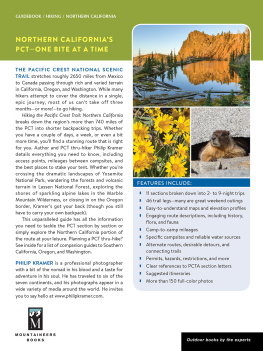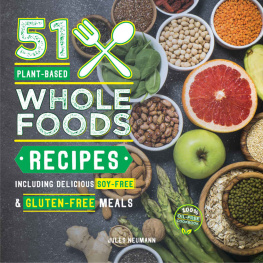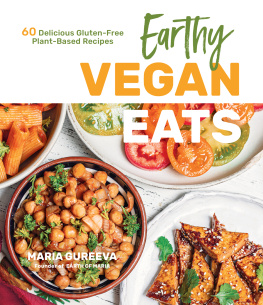
ALLYSON KRAMER
2013 Fair Winds Press
Text 2013 Allyson Kramer
Photography 2013 Fair Winds Press
First published in the USA in 2013 by
Fair Winds Press, a member of
Quayside Publishing Group
100 Cummings Center
Suite 406-L
Beverly, MA 01915-6101
www.fairwindspress.com
All rights reserved. No part of this book may be reproduced or utilized, in any form or by any means, electronic or mechanical, without prior permission in writing from the publisher.
17 16 15 14 13 1 2 3 4 5
Digital edition published in 2013
eISBN: 978-1-61058-746-4
Digital Edition: 978-1-61058-746-4
Softcover Edition: 978-1-59233-548-0
Library of Congress Cataloging-in-Publication Data
Kramer, Allyson.
Great gluten-free vegan eats from around the world : fantastic, allergy-free ethnic recipes / Allyson Kramer.
pages cm
Summary: Great Gluten-Free Vegan Eats from Around the World is a cookbook for the home chef who likes to explore a world of cuisines, regardless of allergies or dietary restrictions. Step inside and travel the globe while still adhering to your plant-based, gluten-free diet with ethnic entrees you may have thought were off-limits, but are actually even better re-imagined! From European classics like Fig Pastries with Clotted Cream and English Cottage Pie to Caribbean specialties like Jamaican Jerk Tofu and Plantain and Potato Soup, youll dine on delicious dishes from all around the globe, while still pleasing every palate at your table. Provided by publisher.
Includes bibliographical references and index.
ISBN 978-1-59233-548-0 (hardback) -- ISBN 978-1-61058-746-4 (digital edition)
1. Gluten-free diet--Recipes. 2. Vegan cooking. 3. International cooking. 4. Food allergy--Diet therapy--Recipes. I. Title.
RM237.86.K734 2013
641.5'636--dc23
2012045854
Cover and book design by Rita Sowins / Sowins Design
Page layout by Daria Perreault
Photography by Allyson Kramer
The information in this book is for educational purposes only. It is not intended to replace the advice of a physician or medical practitioner. Please see your health care provider before beginning any new health program.
This book is dedicated to my beautiful friends who reside all over the world. You constantly inspire me to try out new foods and enjoy flavors Ive never experienced before, many of which have now become staples in my own pantry here on the East Coast of the United States. My kitchen has never smelled so good thanks to all of you.


CHAPTER 1
Global Ingredient Guide
CHAPTER 2
Exploring African Cuisine
CHAPTER 3
European EatsBon Apptit!
CHAPTER 4
Tasty Travels to South and Central America
CHAPTER 5
Fabulous, Fragrant Asian and Oceanic Fare
CHAPTER 6
From Canada to Mexico: A North American Menu



The world is full of mysterious and amazing life that makes up what we call our ecosystem. In that ecosystem exist plants, whose value and contribution to our survival as a species and as individuals may be greater than we will ever know. There are plants that better our eyesight, heal our ailments, and nourish our mind, body, and soul.

AS I STUDY THE EARTHS COUNTLESS SPECIES of edible plants, I have been astounded to find not only the vast differences, but the incredible similarities among them as they are scattered about the globe. For example, apples, pears, and plums can all be found in the same temperate climate from the midwestern United States to China.
Many fruits may grow in hot climates, but did you know that a relative of the cherimoya, a tropical fruit, grows in the United States? Yep, the rolling hills of West Virginia and surrounding areas are home to a peculiar tree called the pawpaw, which has a custardy, almost banana-like interior and is the only tree of this species found outside of the tropics. All over the world you can find these striking similarities and relatives of plants growing and thriving in different regionsall of them sharing two very important qualities: they taste great and are highly nutritious.
My goal with Great Gluten-Free Vegan Eats from Around the World is to introduce you to the amazing food thats featured in different cultures and inspire you to seek out more exotic eats as well as embrace other countries cuisines. No matter where people live in the world, they all love good food. And people from all over the world have done an inspiring job in using the regional fruits and vegetables to their culinary advantage. From moles in Mexico to lolly cakes in New Zealand, we all could stand to gain a little more culture. And why not start where it matters most? Our stomachs!
Even though most chain supermarkets in the United States carry a great many foods from around the world, some of the best places to seek out global delicaciessuch as nori wraps, certain spices including asafetida and curry leaves, and gram flourare Asian, Indian, Mexican, and African markets, if youre fortunate enough to have them nearby. I am a big fan of these kinds of food stores and recommend you become one, too, if you arent already. They are full of the most tantalizing ingredients you wont find at a typical American chain market. From fresh cactus at your local Mexican grocery to stunning dragon fruit at your neighborhood Asian market, these grocery stores are often a goldmine of culinary delights.
Even though many of these foods may seem strange at first glance, they are really not all too different from many foods included in the Standard American Diet. In fact, many of the worlds continental cuisines are heavily influenced by one another. Youd be hard-pressed to find a French dish not romanced with Indias vast spices and the Middle Easts exotic fruits. And yet the southeastern United States and West Africa share such a similar penchant for comfort food that the cuisines have many staples in common such as peanuts, peppers, rice, sweet potatoes, leafy greens, and beans.
When writing this book, I mapped out all the places from where many common fruits, vegetables, grains, herbs, and spices we use today originated and ended up with a fascinating spiderweb of paths. From trading, importing, and exporting, foods from all over ended up in different parts of the world from travel and conquest, and thats how we get the global cuisines we have today. Many dishes are native or local to the region in which they exist (or were introduced early on) and eventually, through exportation, incorporated more ingredients found in other parts of the world
Next page


















